Physical Address
304 North Cardinal St.
Dorchester Center, MA 02124
Physical Address
304 North Cardinal St.
Dorchester Center, MA 02124
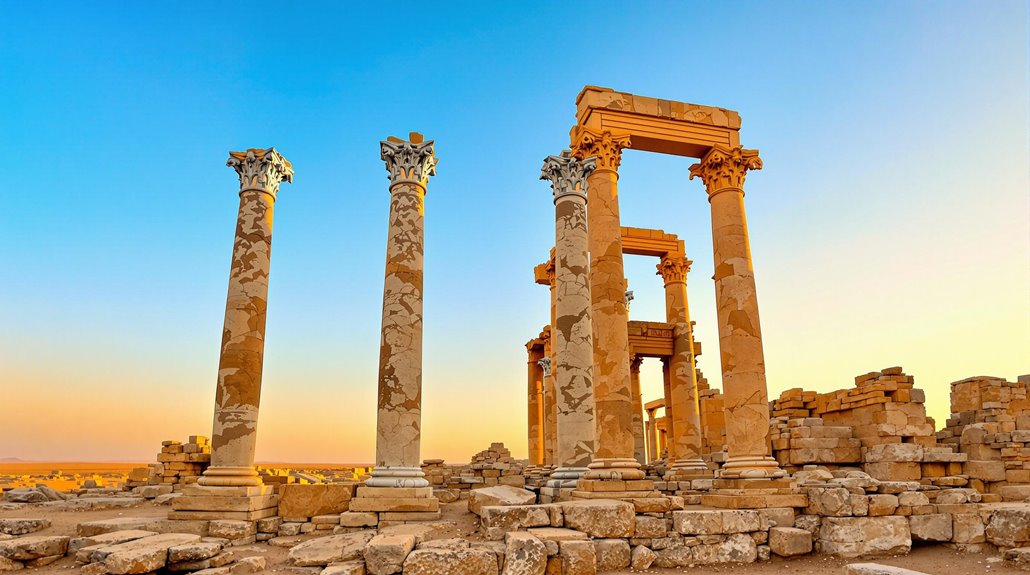
You will discover Palmyra's ancient wonders tucked away in the heart of the Syrian desert, where millennia of history converge in spectacular ruins and timeless architecture. This UNESCO site stands as a demonstration of human ingenuity and cultural exchange, offering more than just photo opportunities of weathered columns and temples. From the majestic Great Colonnade to the mysterious Valley of Tombs, each corner of this desert oasis holds stories waiting to be discovered.
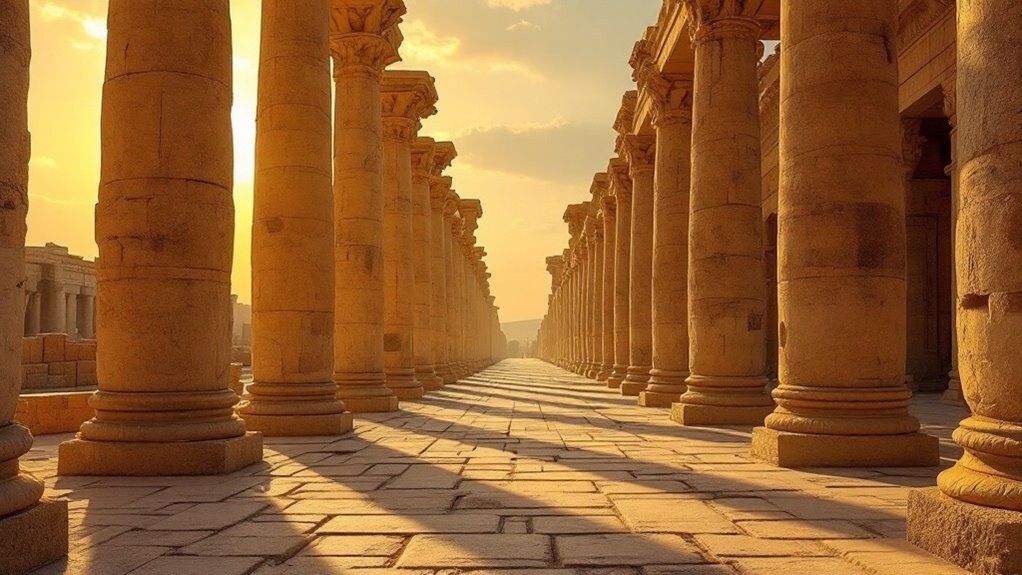
The Great Colonnade stands as Palmyra's most impressive architectural achievement, stretching 1.1 kilometers through the heart of this ancient city.
As you walk between the towering 31-foot Corinthian columns, you'll trace the footsteps of Roman senators, Arab merchants, and religious pilgrims who once gathered beneath ornate bronze statues and bilingual inscriptions.
The earliest columns along this grand boulevard date back to before 158 CE, showcasing the site's remarkable longevity.
You'll discover how the colonnade seamlessly blends Roman engineering with Persian and Arab artistic elements.
Don't miss the remains of the Monumental Arch, which once created a dramatic 30-degree bend in the thoroughfare.
While ISIS destroyed significant portions in 2015, ongoing restoration efforts using photogrammetry and original stonework are reviving this UNESCO World Heritage site.
The eastern section still features intact Roman flagstones, offering you direct contact with the ancient world.
Standing as a masterpiece of ancient architectural fusion, Palmyra's Temple of Bel showcases an unprecedented blend of Greco-Roman and Near Eastern design elements.
You'll discover Corinthian columns standing alongside bent-axis entrances, while Greek, Latin, and Palmyrene Aramaic inscriptions reflect the site's multicultural heritage. This monumental structure, built atop Bronze Age foundations, was capable of hosting thousands within its 205-meter square courtyard. The temple remained an active mosque until 1920s, serving various religious purposes throughout its history.
At the Temple of Bel, you can explore:
Though ISIS destroyed much of the temple in 2015, digital reconstructions now allow you to experience its lost grandeur virtually.
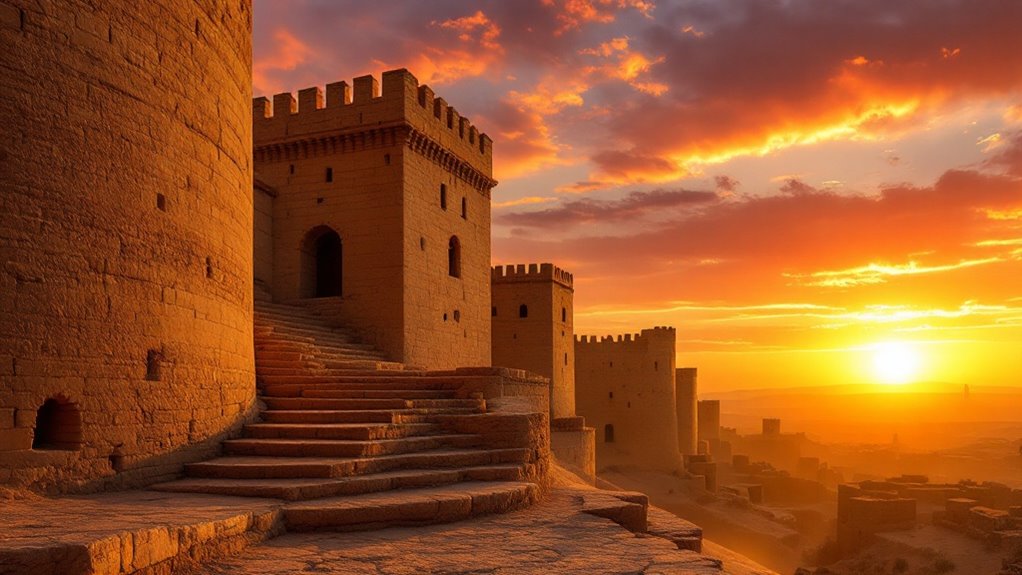
Perched atop a strategic hilltop overlooking ancient Palmyra, Fakhr Ad-Din Citadel offers you the desert's most spectacular sunset views. From its elevated position, you'll witness the golden hour transform the archaeological landscape below, as shadows stretch across the Great Colonnade and remnants of the Temple of Bel.
A single drawbridge access provides the only way to reach this remarkable viewpoint. The best viewing occurs between December and March when temperatures are milder. You'll stand where ancient Palmyrenes once observed astronomical events, gazing out from the 13th-century Mamluk fortress's surviving defensive walls.
Despite damage during the Syrian Civil War, the citadel's basic structure remains intact, with ongoing UNESCO-backed restoration efforts preserving this vital vantage point. The 360-degree desert panorama, framed by undulating dunes and historic ruins, creates stunning photographic opportunities as day turns to dusk.
From the heights of Fakhr Ad-Din Citadel, you can trace the footsteps of Palmyra's most legendary ruler, Queen Zenobia.
As you explore the ancient city, you'll discover how this remarkable empress transformed Palmyra into a powerful empire stretching from Egypt to Turkey. Her legacy lives on in the city's unique architecture, which blends Roman grandeur with Near Eastern influences. Zenobia's mastery of multiple ancient languages enabled her to unite diverse peoples under Palmyrene rule.
Three key stops to understand Zenobia's impact:
Walk these ancient streets to experience firsthand how Zenobia's vision created one of history's most remarkable desert capitals.
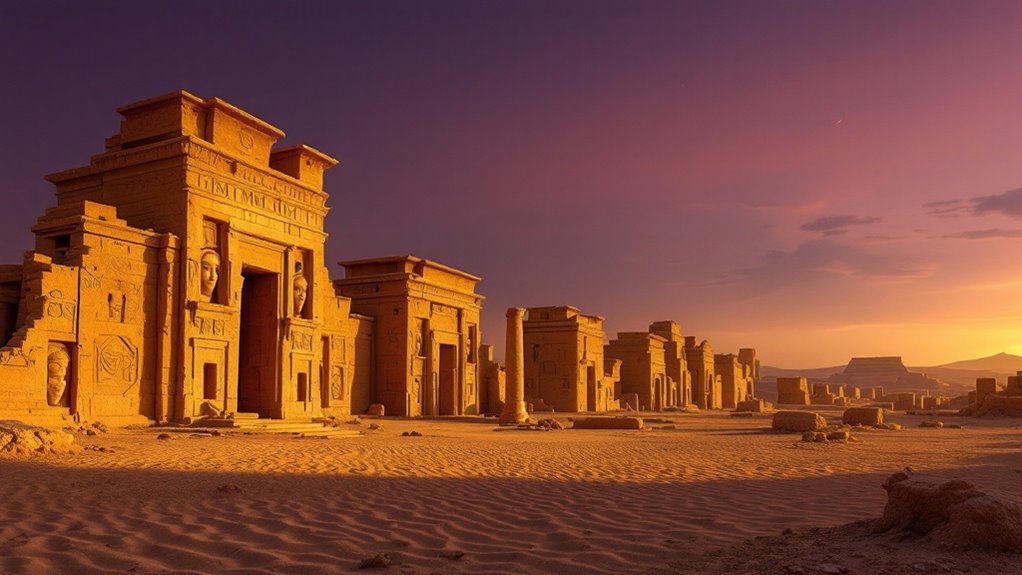
[TEXT]:
Where ancient Palmyrenes laid their dead to rest, the Valley of Tombs stretches westward from the city in a haunting display of architectural grandeur.
You'll discover remnants of over 150 limestone towers that once stood up to 58 feet tall, built between 9 BCE and 273 CE.
Though ISIS destroyed many key structures in 2015, including the towers of Elahbel and Iamblichus, you can still trace the valley's ancient pavement stones and study surviving tomb foundations.
Pre-destruction photographs reveal intricate relief carvings and bilingual inscriptions that mixed Greek, Aramaic, and Latin scripts.
While guided tours have resumed since 2017, they're limited to safer areas around Diocletian's Camp and the Temple of Bel precinct.
UNESCO's ongoing 3D reconstruction projects offer hope for preserving this remarkable funerary landscape.
Standing at the heart of Palmyra's ancient Agora, you'll witness the remnants of one of history's most significant trading hubs.
The limestone benches that line the square once seated merchants haggling over silk, spices, and precious goods from both East and West. You can walk the 1.1km colonnade where bustling shops and stalls once served countless caravans crossing 150km of harsh desert. The city's elegant appearance comes from its use of pale gold limestone throughout its construction.
The site's unique position at the crossroads of empires made it an irreplaceable link in ancient global commerce.
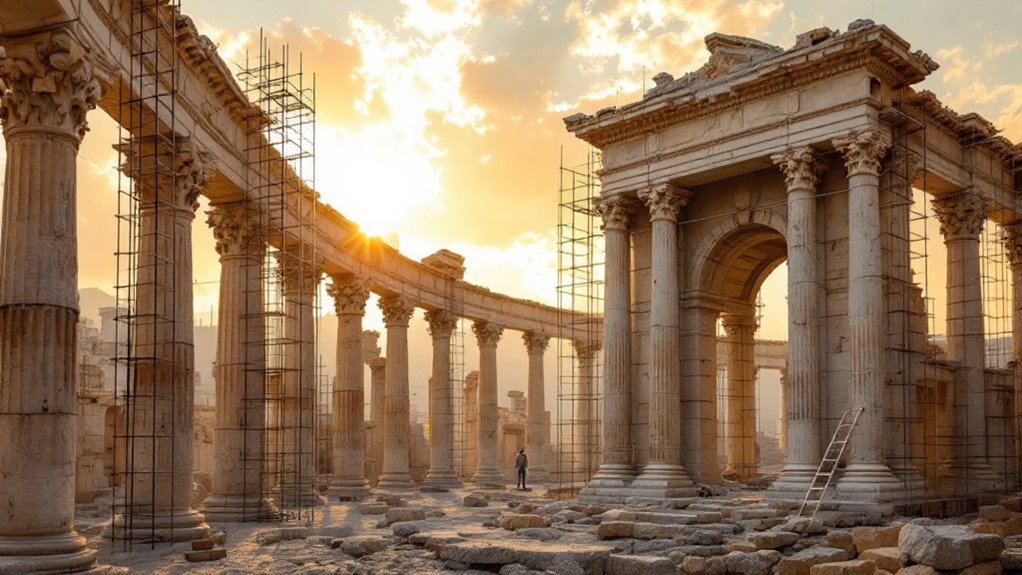
UNESCO's ambitious restoration efforts in Palmyra showcase international cooperation at its finest.
You'll witness the results of global partnerships, including Russian and Polish teams working to restore iconic structures like the Triumphal Arch and the Lion of Al-lāt statue.
As you explore the site, you'll see evidence of extensive damage assessment work that's documented 461 illegal excavations.
The most critical areas – the Citadel, Temple of Bel, and Triumphal Arch – are undergoing urgent stabilization.
While some areas remain fragile, UNESCO's technical experts are implementing innovative solutions, including satellite monitoring to track site conditions.
You can also observe how local communities are being reintegrated into conservation efforts, with the site museum's rehabilitation serving as a focal point for preserving and interpreting Palmyra's cultural legacy.
The restoration teams face ongoing challenges due to lack of funding for emergency interventions to protect damaged structures.
A magical dining experience awaits you beneath Palmyra's star-filled sky, where traditional Bedouin hospitality transforms your evening into an unforgettable culture.
You'll be welcomed with aromatic Arabic coffee and dates in authentic goat-hair tents, positioned perfectly among ancient ruins. The location offers stunning views of UNESCO World Heritage monuments that have stood for millennia.
Experience the richness of Bedouin cuisine through:
As lanterns flicker against the tent's fabric and stars emerge overhead, you'll discover why this centuries-old dining tradition remains an essential part of Palmyra's cultural heritage.
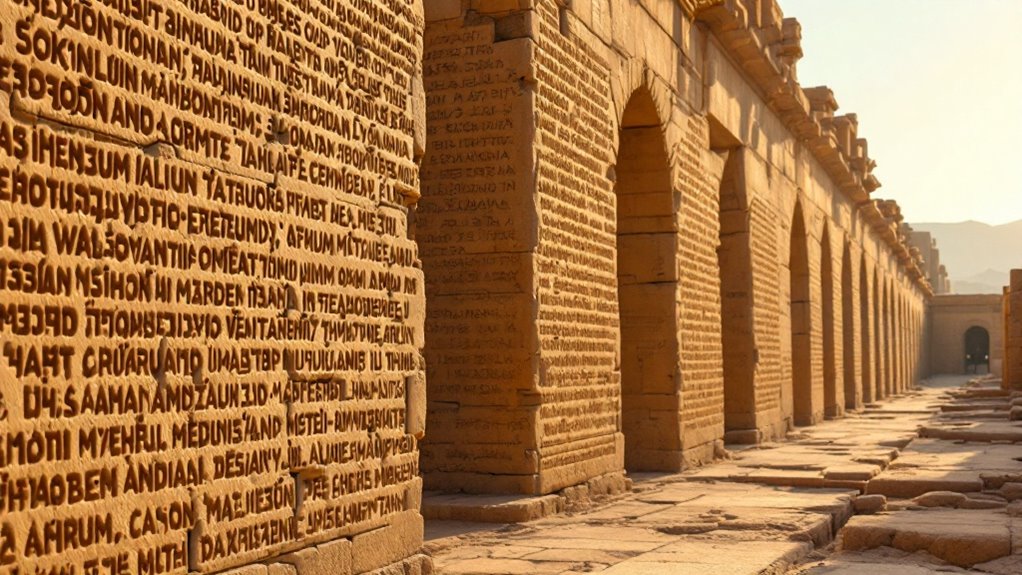
Beyond the enchanting evening feasts, Palmyra's ancient stones tell their own tales through an intricate web of multilingual inscriptions.
You'll discover over 3,000 texts carved in Palmyrene Aramaic, Greek, and Latin, spanning from 44 BCE to 274 CE. These inscriptions reveal fascinating details about trade routes, religious practices, and social hierarchies of this ancient city.
While exploring the ruins, you'll notice the distinctive right-to-left Aramaic script alongside Greek and Latin text. Many artifacts showcase the cultural balance maintained between local Palmyrene traditions and Roman influences.
Don't miss the funerary reliefs with bilingual epitaphs that detail family lineages and social status.
The Wisconsin Palmyrene Aramaic Inscription Project and UNESCO's digital archives can help you understand these ancient messages.
If you're particularly interested, the Louvre Museum houses key artifacts featuring these remarkable multilingual inscriptions.
Walking through Palmyra's ancient streets, you'll trace the footsteps of mighty Roman legions that shaped this desert metropolis.
From the imposing Camp of Diocletian to the fortified Temple of Bel, you can explore the same strategic positions where thousands of troops once protected crucial trade routes.
Positioned at a vital junction of the ancient Silk Roads, this oasis city facilitated trade and cultural exchange between Rome and the Far East.
Follow these key military landmarks to experience Palmyra's Roman heritage:
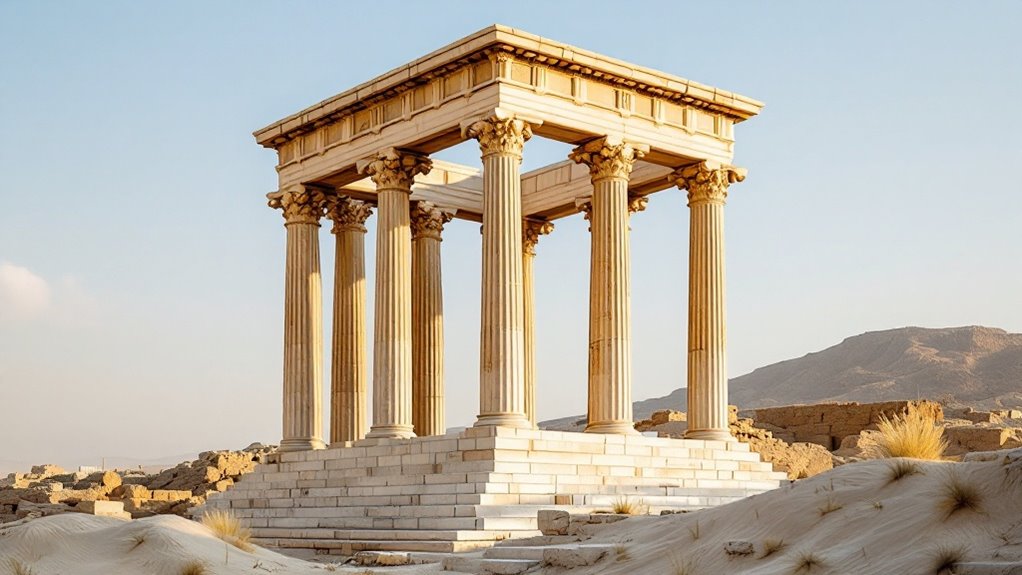
From ancient military outposts to architectural marvels, Palmyra's most photographed landmark stands at the heart of the city's historical crossroads.
The Tetrapylon's restored columns showcase the remarkable fusion of Greco-Roman and Persian influences, offering you unique photography opportunities throughout the day.
You'll get your best shots during golden hour when the sunlight accentuates the local limestone's textures and the Egyptian granite columns' details.
Position yourself at elevated vantage points for panoramic views that highlight the monument's central location along the Grand Colonnade.
For dramatic effect, try night photography to capture the illuminated ruins against the desert's star-filled sky.
While access remains limited due to security concerns, you can still document the ongoing restoration efforts, including 3D-printed replacements and carefully preserved original fragments.
The State Hermitage Museum in St. Petersburg leads the ambitious restoration project to revive this ancient treasure.
Situated at the crossroads of ancient civilizations, Palmyra's oasis transformed a harsh desert outpost into history's most profitable trade hub.
From barren sands to bustling bazaar, Palmyra's desert oasis became the ancient world's greatest marketplace.
You'll discover how this strategic location connected the world's greatest empires, enabling merchants to transport luxury goods between China, India, Persia, and Rome through a sophisticated network of trade routes.
You're walking through a place where camel trains once carried up to 1,000 pounds of cargo per animal across 20-mile daily stretches.
The fertile spring of Eqfa sustained early farmers and herders, establishing the foundation for what would become a thriving metropolis.
You will discover Palmyra's ancient wonders readily accessible, with each site offering clear pathways and informative markers. Pack sturdy walking shoes, sun protection, and water for exploring the ruins. Local guides can enhance your visit with detailed historical context. Check current travel advisories and restoration schedules before booking. The site's convenient location makes it manageable as a day trip from Damascus or part of a longer archaeological tour.